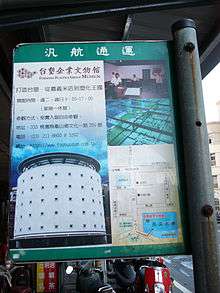Formosa Plastics Group Museum
| 台塑企業文物館 | |
 | |
| Established | 2004 |
|---|---|
| Location | Guishan, Taoyuan City, Taiwan |
The Formosa Plastics Group Museum (Chinese: 台塑企業文物館; pinyin: Táisù Qǐyè Wénwùguǎn), located on the campus of Chang Gung University, Guishan District, Taoyuan City, northern Taiwan, was opened in 2004 to commemorate the 50th anniversary, where the history and culture of the leading Taiwanese company Formosa Plastics Group (FPG) is displayed. There are seven floors of display in the building, totaling 2,837 pings (9379 m²). Wang Yung-ching, nicknamed ‘the God of Management’ by the Japanese, is the founder of the Formosa Plastics Group (FPG), and two floors of museum space are dedicated to his life and the achievements of his company. FPG, with a US$60 billion revenue, contributes over 12% of Taiwan’s GDP in 2007. The company employs over 94,000 people worldwide.[1]
1st floor
In the center of the lobby is an 8.5-ton of Kauri pine, which symbolizes energy and vitality. Kauri pine in the Māori language means “lord of trees”. Together with its long life span and hardness, the Kauri echoes the same impression toward FPG held by the general public in Taiwan. The ground floor also features the company motto, the CIS (corporation identification system), the chronology, the briefing of business sectors in which FPG is involved
2nd floor
The second floor features wax statues and a recreation of Taiwan during Japanese rule. Copies of governmental approval to Formosa Plastics Company, established in 1954, are also documented. The organization chart lists the 40 subsidiaries worldwide in the conglomerate.
3rd floor
The third floor focuses on plastics and chemical fiber sectors. The company had the smallest output in the world at first, but now serves as one of the major PVC producers worldwide. Plastic processing machines (e.g., extruder, injection molding, and miniature calendar) and the company’s first weaving machine are exhibited. Also on display are photographs witnessing the simultaneous surges of the company development and Taiwan’s economic success.
4th floor
The 4th floor, Exhibition of Energy and Electronics Industry, features a large 13.6m × 6.6m (45 ft × 22 ft) 1/600 scale model of FPG’s MiaoLiao Complex. Visitors will walk on the glass floor to get a bird’s-eye view of the 26 square kilometres (6,400 acres) of reclaimed land and a man-made 6 square kilometres (1,483 acres) industrial harbor. The actual reclaimed area is 8 km long and 4 km wide. The man-made harbor has a draft of 24 m (78 ft). This scale model is lit with optical fiber.
With the MaiLiao Project, which includes crude oil refinery, naphtha cracking, olefin, aromatic compound, and the downstream chemical raw materials, FPG successfully accomplished significant organic growth and extension from plastic manufacturing to petrochemical industry.
FPG entered the electronic business by making printed circuit boards (PCB) in 1983. The exhibition also illustrates how FPG extended the backward vertical integration by adding production of epoxy resin (1985), copper-clad laminates (1986), glass yarn (1987), glass fiber (1989), copper foil (1995), ECH and BPA (2001). It took two decades to make the vertical integration complete from oil refinery to PCB.
The MiaoLiao project positions FPG as a major manufacturer in the petrochemical industry and PCB-related material in the world.
An 8-inch (200 mm) silicon ingot, made by Formosa Sumco Technology Corporation, and an 8” DRAM wafer, made by Nanya Technology Corporation, are on the display.
5th floor
The fifth floor introduces the group’s overseas and affiliated companies. Among the many exhibits, models of the first chemical ship and the largest 300,000 ton-oil tanker of the Formosa Marine Corporation are displayed. There is a SCANIA tractor, which allows children to experience daily work of the drivers. Expansion into biotechnology represents the progressive innovation of Taiwan’s oldest conglomerate.
6th floor
Wang Yung-ching contributes to society not just financially. He founded three universities and the largest non-profit private hospital in Taiwan before 1988. A subsidiary, Formosa Heavy Equipment, rebuilt 16 elementary schools after the 921 earthquake, the most powerful quake in Taiwan in decades. All these are presented using scale models.
Basement floor
A briefing room shows a documentary film for FPG and a virtual re-creation of the New Zealand Kauri forest.
See also
External links
- Article in the China Post written by Greg McCann
- Formosa Plastics Group company website (English)
- Museum official website
- Museum English official website
References
- "Annual Reports". Formosa Plastics Group company.
- "National Accounts Yearbook".
Coordinates: 25°02′06″N 121°23′17″E / 25.0350°N 121.3880°E